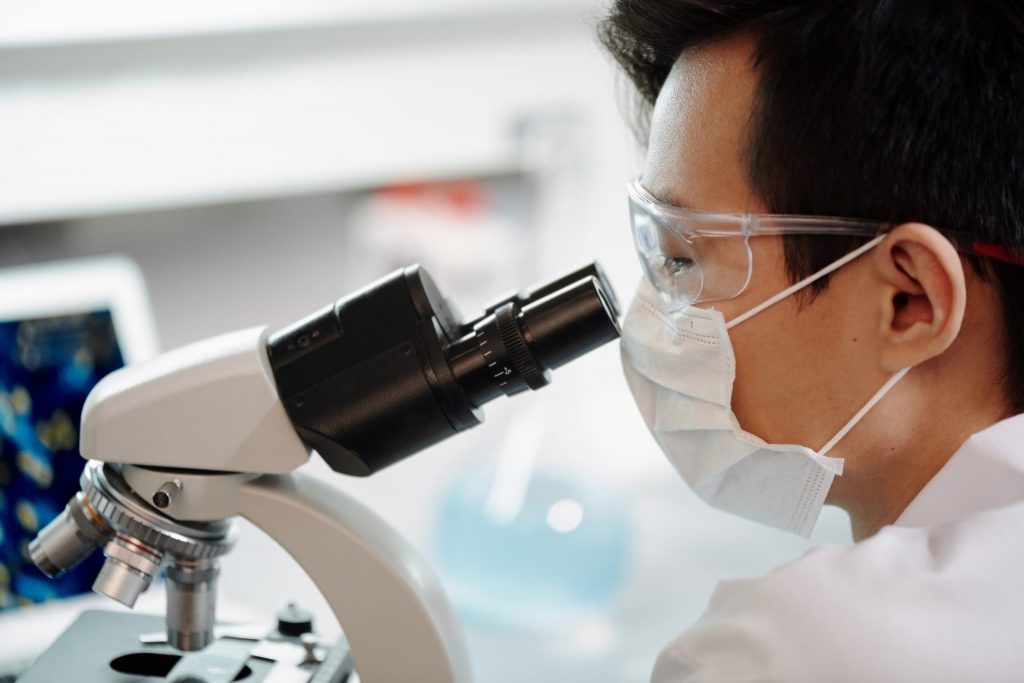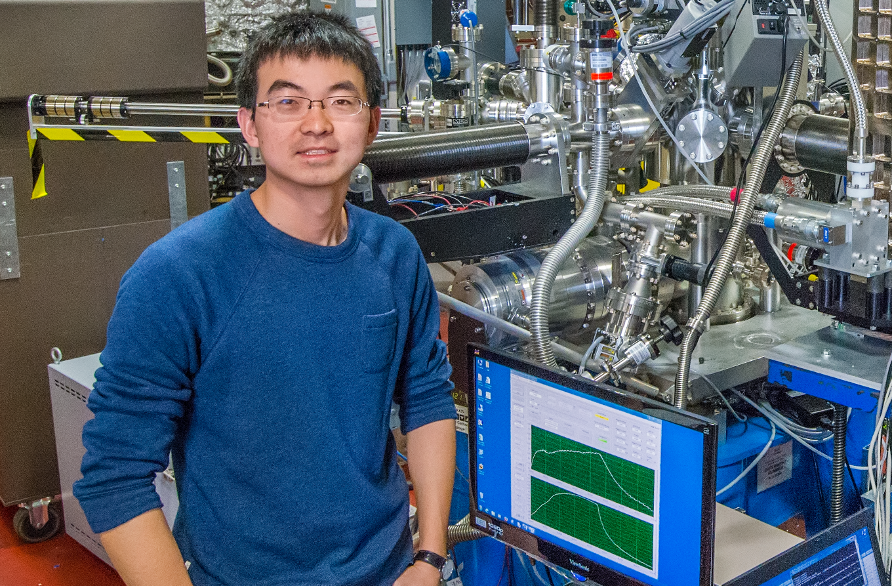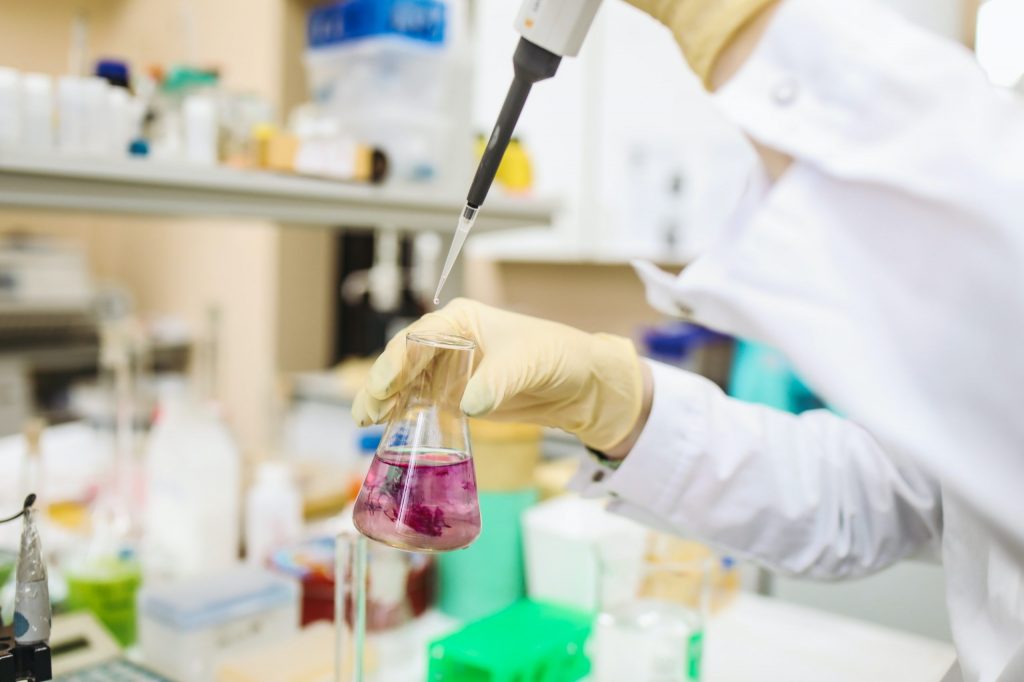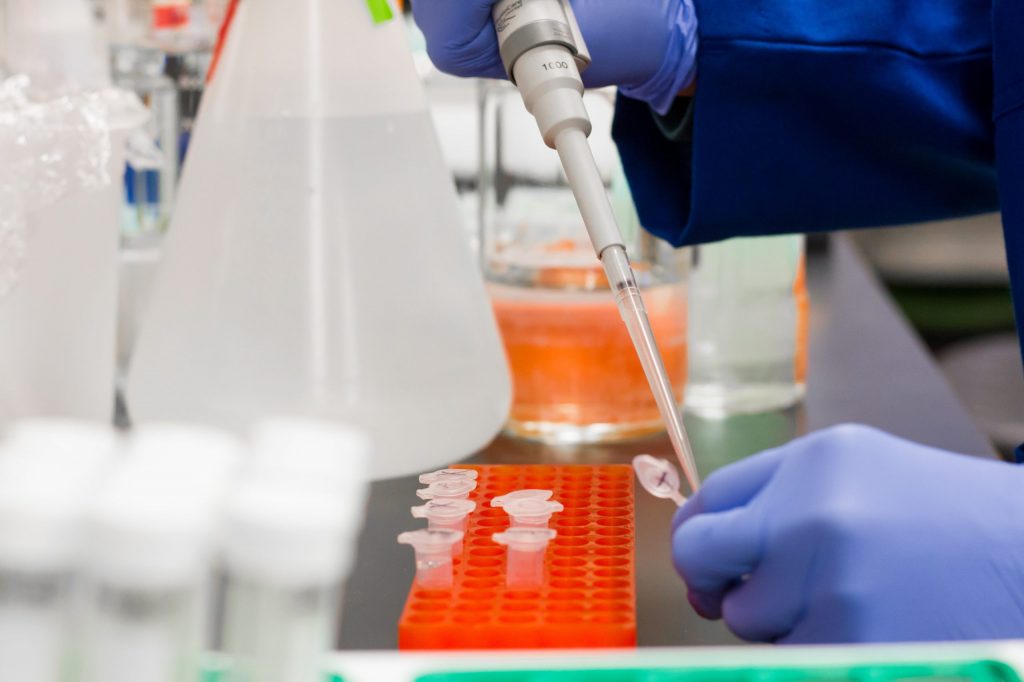Research
The Moulé group chooses research projects in areas that will have maximal long term impact on future science. We focus on development of characterization techniques, data analysis, and model building. Our research efforts can be roughly divided into four larger projects:
Rapid Photothermal-patterning of conjugated polymers
Organic Semiconductors (OSCs) have received widespread attention due to their promising qualities like superior absorbance/emission, easy chemical tunablity, low-temperature solution processing, lightweight and flexible substrates, and low environmental toxicity. A significant obstacle for the industrial development of OSCs is the lack of a patterning technology that is inexpensive, rapid and viable. Photomask lithography is impossible because the OSC cannot withstand the processing steps. The Moule group recently developed a new photopatterning concept that enables nanopatterning of OSC polymers. The principle concept is to turn the OSC into a negative resist and to directly photo-pattern the OSC. We have studied resolution and write speed as functions of the solvent quality, polymer identity, and with various patterning light sources. The patterning rate is proportional light intensity squared, which comes from a highly non-linear etch rate as a function of temperature. This nonlinear rate can be modeled using a single activation energy. Photothermal patterning is a new disruptive paradigm for OSC device processing.
Jacobs, Ian E; Bedolla-Valdez, Zaira I; Rotondo, Brandon T; Bilsky, David J; Lewis, Ryan; Oviedo, Alejandra N Ayala; Gonel, Goktug; Armitage, John; Li, Jun; Moulé, Adam J
Super-Resolution Photothermal Patterning in Conductive Polymers Enabled by Thermally Activated Solubility Journal Article
In: ACS nano, vol. 15, no. 4, pp. 7006–7020, 2021.
@article{jacobs2021super,
title = {Super-Resolution Photothermal Patterning in Conductive Polymers Enabled by Thermally Activated Solubility},
author = {Ian E Jacobs and Zaira I Bedolla-Valdez and Brandon T Rotondo and David J Bilsky and Ryan Lewis and Alejandra N Ayala Oviedo and Goktug Gonel and John Armitage and Jun Li and Adam J Moulé},
doi = {https://doi.org/10.1021/acsnano.1c00070},
year = {2021},
date = {2021-01-01},
urldate = {2021-01-01},
journal = {ACS nano},
volume = {15},
number = {4},
pages = {7006--7020},
publisher = {ACS Publications},
keywords = {},
pubstate = {published},
tppubtype = {article}
}
Bedolla-Valdez, Zaira I; Xiao, Rui; Cendra, Camila; Fergerson, Alice S; Chen, Zekun; Gonel, Goktug; Salleo, Alberto; Yu, Dong; Moulé, Adam J
Reversible Doping and Photo Patterning of Polymer Nanowires Journal Article
In: Advanced Electronic Materials, vol. 6, no. 10, pp. 2000469, 2020.
@article{bedolla2020reversible,
title = {Reversible Doping and Photo Patterning of Polymer Nanowires},
author = {Zaira I Bedolla-Valdez and Rui Xiao and Camila Cendra and Alice S Fergerson and Zekun Chen and Goktug Gonel and Alberto Salleo and Dong Yu and Adam J Moulé},
year = {2020},
date = {2020-01-01},
journal = {Advanced Electronic Materials},
volume = {6},
number = {10},
pages = {2000469},
publisher = {Wiley Online Library},
keywords = {},
pubstate = {published},
tppubtype = {article}
}
Jacobs, Ian E; Bedolla-Valdez, Zaira I; Rotondo, Brandon T; Bilsky, David J; Lewis, Ryan; Oviedo, Alejandra N Ayala; Gonel, Goktug; Armitage, John; Li, Jun; Moulé, Adam J
Super-Resolution Photothermal Patterning in Conductive Polymers Enabled by Thermally Activated Solubility Journal Article
In: ACS nano, vol. 15, no. 4, pp. 7006–7020, 2021.
@article{jacobs2021super,
title = {Super-Resolution Photothermal Patterning in Conductive Polymers Enabled by Thermally Activated Solubility},
author = {Ian E Jacobs and Zaira I Bedolla-Valdez and Brandon T Rotondo and David J Bilsky and Ryan Lewis and Alejandra N Ayala Oviedo and Goktug Gonel and John Armitage and Jun Li and Adam J Moulé},
doi = {https://doi.org/10.1021/acsnano.1c00070},
year = {2021},
date = {2021-01-01},
urldate = {2021-01-01},
journal = {ACS nano},
volume = {15},
number = {4},
pages = {7006--7020},
publisher = {ACS Publications},
keywords = {},
pubstate = {published},
tppubtype = {article}
}
Bedolla-Valdez, Zaira I; Xiao, Rui; Cendra, Camila; Fergerson, Alice S; Chen, Zekun; Gonel, Goktug; Salleo, Alberto; Yu, Dong; Moulé, Adam J
Reversible Doping and Photo Patterning of Polymer Nanowires Journal Article
In: Advanced Electronic Materials, vol. 6, no. 10, pp. 2000469, 2020.
@article{bedolla2020reversible,
title = {Reversible Doping and Photo Patterning of Polymer Nanowires},
author = {Zaira I Bedolla-Valdez and Rui Xiao and Camila Cendra and Alice S Fergerson and Zekun Chen and Goktug Gonel and Alberto Salleo and Dong Yu and Adam J Moulé},
year = {2020},
date = {2020-01-01},
journal = {Advanced Electronic Materials},
volume = {6},
number = {10},
pages = {2000469},
publisher = {Wiley Online Library},
keywords = {},
pubstate = {published},
tppubtype = {article}
}
Doping of conjugated polymers
Molecular doping is the process of adding a molecule to a OSC that adds or removes an electron to the polymer backbone, and thereby greatly increases the charge conductivity. Unlike inorganic doping, a molecular dopant is in equilibrium with the lattice and only has a probability to ionize based on energetics. The Moule group invented a process called sequential solution doping that enables separate processing of the polymer and dopant and more efficient dopant ionization. This discovery led to new research on soluble molecular dopants with increased doping potential. Unfortunately, soluble dopant diffuse in the polymer matrix. We developed an optical microscopy based technique to quantify dopant diffusion. Another project in molecular doping is to quantify the doping level as a function of the solution dopant concentration. We also focus on exchange reactions that replace molecular dopants with non-reversible ions that lead to doping levels of >70% for many polymers.
Murrey, Tucker L; Riley, Margaret A; Gonel, Goktug; Antonio, Dexter D; Filardi, Leah; Shevchenko, Nikolay; Mascal, Mark; Moulé, Adam J
Anion Exchange Doping: Tuning Equilibrium to Increase Doping Efficiency in Semiconducting Polymers Journal Article
In: The journal of physical chemistry letters, vol. 12, no. 4, pp. 1284–1289, 2021.
@article{murrey2021anion,
title = {Anion Exchange Doping: Tuning Equilibrium to Increase Doping Efficiency in Semiconducting Polymers},
author = {Tucker L Murrey and Margaret A Riley and Goktug Gonel and Dexter D Antonio and Leah Filardi and Nikolay Shevchenko and Mark Mascal and Adam J Moulé},
doi = {https://doi.org/10.1021/acs.jpclett.0c03620},
year = {2021},
date = {2021-01-01},
urldate = {2021-01-01},
journal = {The journal of physical chemistry letters},
volume = {12},
number = {4},
pages = {1284--1289},
publisher = {ACS Publications},
keywords = {},
pubstate = {published},
tppubtype = {article}
}
Jacobs, Ian E; Moulé, Adam J
Controlling molecular doping in organic semiconductors Journal Article
In: Advanced Materials, vol. 29, no. 42, pp. 1703063, 2017.
@article{jacobs2017controlling,
title = {Controlling molecular doping in organic semiconductors},
author = {Ian E Jacobs and Adam J Moulé},
year = {2017},
date = {2017-01-01},
journal = {Advanced Materials},
volume = {29},
number = {42},
pages = {1703063},
publisher = {Wiley Online Library},
keywords = {},
pubstate = {published},
tppubtype = {article}
}
Jacobs, Ian E; Aasen, Erik W; Oliveira, Julia L; Fonseca, Tayane N; Roehling, John D; Li, Jun; Zhang, Gwangwu; Augustine, Matthew P; Mascal, Mark; Moulé, Adam J
Comparison of solution-mixed and sequentially processed P3HT: F4TCNQ films: effect of doping-induced aggregation on film morphology Journal Article
In: Journal of Materials Chemistry C, vol. 4, no. 16, pp. 3454–3466, 2016.
@article{jacobs2016comparison,
title = {Comparison of solution-mixed and sequentially processed P3HT: F4TCNQ films: effect of doping-induced aggregation on film morphology},
author = {Ian E Jacobs and Erik W Aasen and Julia L Oliveira and Tayane N Fonseca and John D Roehling and Jun Li and Gwangwu Zhang and Matthew P Augustine and Mark Mascal and Adam J Moulé},
year = {2016},
date = {2016-01-01},
journal = {Journal of Materials Chemistry C},
volume = {4},
number = {16},
pages = {3454--3466},
publisher = {Royal Society of Chemistry},
keywords = {},
pubstate = {published},
tppubtype = {article}
}
Li, Jun; Rochester, Chris W; Jacobs, Ian E; Friedrich, Stephan; Stroeve, Pieter; Riede, Moritz; Moulé, Adam J
Measurement of small molecular dopant F4TCNQ and C60F36 diffusion in organic bilayer architectures Journal Article
In: ACS applied materials & interfaces, vol. 7, no. 51, pp. 28420–28428, 2015.
@article{li2015measurement,
title = {Measurement of small molecular dopant F4TCNQ and C60F36 diffusion in organic bilayer architectures},
author = {Jun Li and Chris W Rochester and Ian E Jacobs and Stephan Friedrich and Pieter Stroeve and Moritz Riede and Adam J Moulé},
year = {2015},
date = {2015-01-01},
journal = {ACS applied materials & interfaces},
volume = {7},
number = {51},
pages = {28420--28428},
publisher = {ACS Publications},
keywords = {},
pubstate = {published},
tppubtype = {article}
}
Murrey, Tucker L; Riley, Margaret A; Gonel, Goktug; Antonio, Dexter D; Filardi, Leah; Shevchenko, Nikolay; Mascal, Mark; Moulé, Adam J
Anion Exchange Doping: Tuning Equilibrium to Increase Doping Efficiency in Semiconducting Polymers Journal Article
In: The journal of physical chemistry letters, vol. 12, no. 4, pp. 1284–1289, 2021.
@article{murrey2021anion,
title = {Anion Exchange Doping: Tuning Equilibrium to Increase Doping Efficiency in Semiconducting Polymers},
author = {Tucker L Murrey and Margaret A Riley and Goktug Gonel and Dexter D Antonio and Leah Filardi and Nikolay Shevchenko and Mark Mascal and Adam J Moulé},
doi = {https://doi.org/10.1021/acs.jpclett.0c03620},
year = {2021},
date = {2021-01-01},
urldate = {2021-01-01},
journal = {The journal of physical chemistry letters},
volume = {12},
number = {4},
pages = {1284--1289},
publisher = {ACS Publications},
keywords = {},
pubstate = {published},
tppubtype = {article}
}
Jacobs, Ian E; Moulé, Adam J
Controlling molecular doping in organic semiconductors Journal Article
In: Advanced Materials, vol. 29, no. 42, pp. 1703063, 2017.
@article{jacobs2017controlling,
title = {Controlling molecular doping in organic semiconductors},
author = {Ian E Jacobs and Adam J Moulé},
year = {2017},
date = {2017-01-01},
journal = {Advanced Materials},
volume = {29},
number = {42},
pages = {1703063},
publisher = {Wiley Online Library},
keywords = {},
pubstate = {published},
tppubtype = {article}
}
Jacobs, Ian E; Aasen, Erik W; Oliveira, Julia L; Fonseca, Tayane N; Roehling, John D; Li, Jun; Zhang, Gwangwu; Augustine, Matthew P; Mascal, Mark; Moulé, Adam J
Comparison of solution-mixed and sequentially processed P3HT: F4TCNQ films: effect of doping-induced aggregation on film morphology Journal Article
In: Journal of Materials Chemistry C, vol. 4, no. 16, pp. 3454–3466, 2016.
@article{jacobs2016comparison,
title = {Comparison of solution-mixed and sequentially processed P3HT: F4TCNQ films: effect of doping-induced aggregation on film morphology},
author = {Ian E Jacobs and Erik W Aasen and Julia L Oliveira and Tayane N Fonseca and John D Roehling and Jun Li and Gwangwu Zhang and Matthew P Augustine and Mark Mascal and Adam J Moulé},
year = {2016},
date = {2016-01-01},
journal = {Journal of Materials Chemistry C},
volume = {4},
number = {16},
pages = {3454--3466},
publisher = {Royal Society of Chemistry},
keywords = {},
pubstate = {published},
tppubtype = {article}
}
Li, Jun; Rochester, Chris W; Jacobs, Ian E; Friedrich, Stephan; Stroeve, Pieter; Riede, Moritz; Moulé, Adam J
Measurement of small molecular dopant F4TCNQ and C60F36 diffusion in organic bilayer architectures Journal Article
In: ACS applied materials & interfaces, vol. 7, no. 51, pp. 28420–28428, 2015.
@article{li2015measurement,
title = {Measurement of small molecular dopant F4TCNQ and C60F36 diffusion in organic bilayer architectures},
author = {Jun Li and Chris W Rochester and Ian E Jacobs and Stephan Friedrich and Pieter Stroeve and Moritz Riede and Adam J Moulé},
year = {2015},
date = {2015-01-01},
journal = {ACS applied materials & interfaces},
volume = {7},
number = {51},
pages = {28420--28428},
publisher = {ACS Publications},
keywords = {},
pubstate = {published},
tppubtype = {article}
}
Inelastic Neutron Scattering (INS)
Molecular vibrations play an important role in scientific areas ranging from charge transport in organic semiconductors. We are known for producing the highest-quality predictions of molecular vibrations in organic semiconductors using INS. Recently, we are trying to expand our work to non-crystalline materials such as conjugated polymers. We are training machine learning force fields and apply them on molecular dynamics INS simulation. This work is known as the Davis Computational Spectroscopy (DCS) project and includes a computational workflow (Welcome to DCS-Flow’s documentation! — DCS-Flow documentation) as well as a repository of past calculations https://dcs-discover.web.app/
Harrelson, Thomas F; Dettmann, Makena; Scherer, Christoph; Andrienko, Denis; Moulé, Adam J; Faller, Roland
Computing inelastic neutron scattering spectra from molecular dynamics trajectories Journal Article
In: Scientific reports, vol. 11, no. 1, pp. 1–12, 2021.
@article{harrelson2021computing,
title = {Computing inelastic neutron scattering spectra from molecular dynamics trajectories},
author = {Thomas F Harrelson and Makena Dettmann and Christoph Scherer and Denis Andrienko and Adam J Moulé and Roland Faller},
doi = {https://doi.org/10.1038/s41598-021-86771-5},
year = {2021},
date = {2021-01-01},
urldate = {2021-01-01},
journal = {Scientific reports},
volume = {11},
number = {1},
pages = {1--12},
publisher = {Nature Publishing Group},
keywords = {},
pubstate = {published},
tppubtype = {article}
}
Harrelson, Thomas F; Dantanarayana, Varuni; Xie, Xiaoyu; Koshnick, Correy; Nai, Dingqi; Fair, Ryan; nez, Sean A Nu; Thomas, Alan K; Murrey, Tucker L; Hickner, Michael A; others,
Direct probe of the nuclear modes limiting charge mobility in molecular semiconductors Journal Article
In: Materials Horizons, vol. 6, no. 1, pp. 182–191, 2019.
@article{harrelson2019direct,
title = {Direct probe of the nuclear modes limiting charge mobility in molecular semiconductors},
author = {Thomas F Harrelson and Varuni Dantanarayana and Xiaoyu Xie and Correy Koshnick and Dingqi Nai and Ryan Fair and Sean A Nu{~n}ez and Alan K Thomas and Tucker L Murrey and Michael A Hickner and others},
year = {2019},
date = {2019-01-01},
journal = {Materials Horizons},
volume = {6},
number = {1},
pages = {182--191},
publisher = {Royal Society of Chemistry},
keywords = {},
pubstate = {published},
tppubtype = {article}
}
Harrelson, Thomas; Dantanarayana, Varuni; Bonilla, Alejandro; Troisi, Allesandro; Faller, Roland; Moule, Adam
Towards Novel Organic Electronics: Integrating Simulation and Neutron Scattering Proceedings Article
In: APS March Meeting Abstracts, pp. P56–009, 2018.
@inproceedings{harrelson2018towards,
title = {Towards Novel Organic Electronics: Integrating Simulation and Neutron Scattering},
author = {Thomas Harrelson and Varuni Dantanarayana and Alejandro Bonilla and Allesandro Troisi and Roland Faller and Adam Moule},
year = {2018},
date = {2018-01-01},
booktitle = {APS March Meeting Abstracts},
volume = {2018},
pages = {P56--009},
keywords = {},
pubstate = {published},
tppubtype = {inproceedings}
}
Harrelson, Thomas F; Dettmann, Makena; Scherer, Christoph; Andrienko, Denis; Moulé, Adam J; Faller, Roland
Computing inelastic neutron scattering spectra from molecular dynamics trajectories Journal Article
In: Scientific reports, vol. 11, no. 1, pp. 1–12, 2021.
@article{harrelson2021computing,
title = {Computing inelastic neutron scattering spectra from molecular dynamics trajectories},
author = {Thomas F Harrelson and Makena Dettmann and Christoph Scherer and Denis Andrienko and Adam J Moulé and Roland Faller},
doi = {https://doi.org/10.1038/s41598-021-86771-5},
year = {2021},
date = {2021-01-01},
urldate = {2021-01-01},
journal = {Scientific reports},
volume = {11},
number = {1},
pages = {1--12},
publisher = {Nature Publishing Group},
keywords = {},
pubstate = {published},
tppubtype = {article}
}
Harrelson, Thomas F; Dantanarayana, Varuni; Xie, Xiaoyu; Koshnick, Correy; Nai, Dingqi; Fair, Ryan; nez, Sean A Nu; Thomas, Alan K; Murrey, Tucker L; Hickner, Michael A; others,
Direct probe of the nuclear modes limiting charge mobility in molecular semiconductors Journal Article
In: Materials Horizons, vol. 6, no. 1, pp. 182–191, 2019.
@article{harrelson2019direct,
title = {Direct probe of the nuclear modes limiting charge mobility in molecular semiconductors},
author = {Thomas F Harrelson and Varuni Dantanarayana and Xiaoyu Xie and Correy Koshnick and Dingqi Nai and Ryan Fair and Sean A Nu{~n}ez and Alan K Thomas and Tucker L Murrey and Michael A Hickner and others},
year = {2019},
date = {2019-01-01},
journal = {Materials Horizons},
volume = {6},
number = {1},
pages = {182--191},
publisher = {Royal Society of Chemistry},
keywords = {},
pubstate = {published},
tppubtype = {article}
}
Harrelson, Thomas; Dantanarayana, Varuni; Bonilla, Alejandro; Troisi, Allesandro; Faller, Roland; Moule, Adam
Towards Novel Organic Electronics: Integrating Simulation and Neutron Scattering Proceedings Article
In: APS March Meeting Abstracts, pp. P56–009, 2018.
@inproceedings{harrelson2018towards,
title = {Towards Novel Organic Electronics: Integrating Simulation and Neutron Scattering},
author = {Thomas Harrelson and Varuni Dantanarayana and Alejandro Bonilla and Allesandro Troisi and Roland Faller and Adam Moule},
year = {2018},
date = {2018-01-01},
booktitle = {APS March Meeting Abstracts},
volume = {2018},
pages = {P56--009},
keywords = {},
pubstate = {published},
tppubtype = {inproceedings}
}
Near-Atomistic Electron Tomographic Imaging
The Moule group uses Electron tomography to study the structure of three-dimensional functional materials. First we studied organic photovoltaic devices made with various polymers and a fullerene acceptor with a metal cluster in the fullerene. The metal cluster made an excellent contrast agent for the microscopy. Found that a BHJ layer required three phases, polymer rich, fullerene rich, and mixed and that the composition of these phases could be quantified. Using tomography we studied the effects of annealing, polymer/fullerene ratio, vertical segregation at metal electrodes, and blade coated vs spin coated films. We also used the tomograms to create 3D charge transport models. The best publication in this area was recently completed in collaboration with Jean Luc Bredas
Li, Haoyuan; Sini, Gjergji; Sit, Joseph; Moulé, Adam J; Bredas, Jean-Luc
Understanding charge transport in donor/acceptor blends from large-scale device simulations based on experimental film morphologies Journal Article
In: Energy & Environmental Science, vol. 13, no. 2, pp. 601–615, 2020.
@article{li2020understanding,
title = {Understanding charge transport in donor/acceptor blends from large-scale device simulations based on experimental film morphologies},
author = {Haoyuan Li and Gjergji Sini and Joseph Sit and Adam J Moulé and Jean-Luc Bredas},
year = {2020},
date = {2020-01-01},
journal = {Energy & Environmental Science},
volume = {13},
number = {2},
pages = {601--615},
publisher = {Royal Society of Chemistry},
keywords = {},
pubstate = {published},
tppubtype = {article}
}
Li, Haoyuan; Sini, Gjergji; Sit, Joseph; Moulé, Adam J; Bredas, Jean-Luc
Understanding charge transport in donor/acceptor blends from large-scale device simulations based on experimental film morphologies Journal Article
In: Energy & Environmental Science, vol. 13, no. 2, pp. 601–615, 2020.
@article{li2020understanding,
title = {Understanding charge transport in donor/acceptor blends from large-scale device simulations based on experimental film morphologies},
author = {Haoyuan Li and Gjergji Sini and Joseph Sit and Adam J Moulé and Jean-Luc Bredas},
year = {2020},
date = {2020-01-01},
journal = {Energy & Environmental Science},
volume = {13},
number = {2},
pages = {601--615},
publisher = {Royal Society of Chemistry},
keywords = {},
pubstate = {published},
tppubtype = {article}
}
The current material we are working on is Quantum dot super lattices. QDs are versatile building blocks whose interactions (electronic and excitonic) in self-assembled solids can be tuned by changing QD size, size distribution, shape, inter-QD spacing, spatial ordering, surface chemistry, and QD-QD bridging. We are developing advanced experimental and analytical tomographic tools to study and draw correlations between these microscopic and mesoscopic structural features aiming for establishing better charge transport model and better material fabrications.
Chu, Xiaolei; Heidari, Hamed; Abelson, Alex; Unruh, Davis; Hansen, Chase; Qian, Caroline; Zimanyi, Gergely; Law, Matt; Moulé, Adam J
Structural characterization of a polycrystalline epitaxially-fused colloidal quantum dot superlattice by electron tomography Journal Article
In: Journal of Materials Chemistry A, vol. 8, no. 35, pp. 18254–18265, 2020.
@article{chu2020structural,
title = {Structural characterization of a polycrystalline epitaxially-fused colloidal quantum dot superlattice by electron tomography},
author = {Xiaolei Chu and Hamed Heidari and Alex Abelson and Davis Unruh and Chase Hansen and Caroline Qian and Gergely Zimanyi and Matt Law and Adam J Moulé},
year = {2020},
date = {2020-01-01},
journal = {Journal of Materials Chemistry A},
volume = {8},
number = {35},
pages = {18254--18265},
publisher = {The Royal Society of Chemistry},
keywords = {},
pubstate = {published},
tppubtype = {article}
}
Chu, Xiaolei; Heidari, Hamed; Abelson, Alex; Unruh, Davis; Hansen, Chase; Qian, Caroline; Zimanyi, Gergely; Law, Matt; Moulé, Adam J
Structural characterization of a polycrystalline epitaxially-fused colloidal quantum dot superlattice by electron tomography Journal Article
In: Journal of Materials Chemistry A, vol. 8, no. 35, pp. 18254–18265, 2020.
@article{chu2020structural,
title = {Structural characterization of a polycrystalline epitaxially-fused colloidal quantum dot superlattice by electron tomography},
author = {Xiaolei Chu and Hamed Heidari and Alex Abelson and Davis Unruh and Chase Hansen and Caroline Qian and Gergely Zimanyi and Matt Law and Adam J Moulé},
year = {2020},
date = {2020-01-01},
journal = {Journal of Materials Chemistry A},
volume = {8},
number = {35},
pages = {18254--18265},
publisher = {The Royal Society of Chemistry},
keywords = {},
pubstate = {published},
tppubtype = {article}
}



